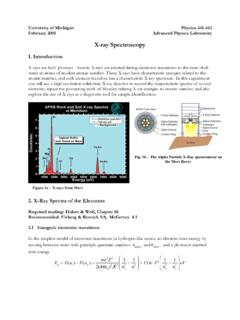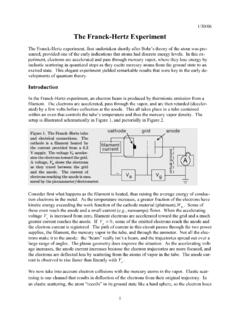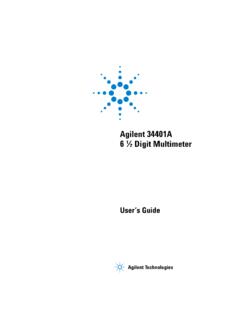Transcription of Electron Diffraction and Crystal Structure
1 University of Michigan Physics 441-442 2/9/06 Advanced Physics Laboratory Electron Diffraction and Crystal Structure 1. Introduction In classical mechanics we describe motion by assigning momenta to point particles. In quantum mechanics we learn that the motion of particles is also described by waves, with the crucial parameters of the two viewpoints related through the de Broglie relation: !=hp [1] where p is the momentum, is the wavelength, and h is Planck s constant h= !10"34J#s= !10"15eV#s. To observe wave-like behavior, we require some kind of grating where the distance between slits is of order the wavelength. At typical laboratory energies, the Electron s de Broglie wavelength is of order one Angstrom (10 8 cm), about the same size as the interatomic spacings in common crystals.
2 The regular atomic arrays in crystals are thus perfectly scaled gratings for creating a matter wave Diffraction pattern, measuring their wavelength, and verifying Eq. 1. As an added bonus, with the principle verified, the Diffraction patterns then become powerful tools for the study of Crystal Structure . In this experiment, you will use a cathode ray tube with a graphite Crystal target that shows the Diffraction pattern on the screen. You will verify the de Broglie relation, and analyze Crystal structures, including measurement of the inter-atomic distance in the Crystal . 2. Basic Principles a. The de Broglie Wavelength vs. Voltage In the cathode ray tube the Electron is accelerated through high voltage V. Its energy and momentum are then given by E=p22m=eV [2] Solving for the momentum, and substituting into Eq. 1 gives: !
3 =h2eVm [3] You should verify for yourself that this can be re-written in the practical form !(Angstroms)= (volts) [4] Thus, a 150 V Electron has a de Broglie wavelength of 1 Angstrom, and the wavelength should vary in inverse proportional to the accelerating voltage. b. Crystal Lattice Spacing A Crystal is a very regular array of atoms. The regularity can be quantified in terms of certain small patterns of atoms, called unit cells, which are repeated over and over again. Since the vertices of 2/9/06 2 Electron Diffraction the unit cell are atoms, the size of the unit cell is related to the inter-atomic spacing, or lattice constant, which is usually called a. This experiment will be done with a graphite (carbon) Crystal that has a hexagonal Structure . For a simple hexagonal Crystal such as graphite, the lattice is as shown below.
4 The (100) and (110) planes, which respectively give rise to the inner and outer rings in the Electron Diffraction tube, are shown at right; the ratio of the d-spacings d100/d110 = 3:1. These spacings have been defined in terms of the unit vectors a and b where a = b in the case of the hexagonal Structure . The indices (100), (110), etc. are known as Miller indices. Figure 1: The unit cell and lattice spacings for graphite. c. Bragg Reflection A rigorous description of Crystal Diffraction starts with a plane wave of electrons, treats each atom as an individual source of re-scattered spherical waves, and solves the three-dimensional problem of summing over all the expanding wavefronts. The standard solution is very interesting and elegant application of crystallography and Fourier analysis. You may enjoy the treatment in Chapters 1-2 of Kittel, which start from the Diffraction problem and build up a theory of Crystal Structure , or Chapter 4-6 of Ashcroft and Mermin, which start from crystallography and then develop an analysis of Diffraction .
5 However, as is frequently the case, there is a somewhat heuristic description based on a simple physical model, which is easy to understand, and gets exactly the right answer. This picture was formulated by and W. L. Bragg (father and son) in 1913, in order to explain very sharp peaks observed at certain angles in the reflection of x-rays from crystals. This work won the Braggs the Nobel Prize in 1915. Because it is really about the wave nature of the scatterer, the Bragg picture applies equally well to electrons. We think of the regular array in the Crystal in terms of planes of atoms. Each plane reflects wave like a simple plane mirror, with the angle of reflection equal to the angle of incidence ( specular reflection). 2/9/06 3 Electron Diffraction Figure 2 Bragg's picture of Crystal Diffraction as multiple specular reflections.
6 The sum of the reflections from a large number of parallel mirrors all separated by the same distance, d , will produce strong Diffraction peaks when the angle between the beam and surface satisfies the Bragg condition 2dsin!=n" [5] In 1927, fourteen years after Bragg s work with x-rays, Davison and Germer, working at Bell Labs, observed a strong Diffraction peak in Electron scattering from nickel. The wavelength of the Electron wave , as calculated from the Bragg formula and the lattice constant of nickel, was exactly as predicted by de Broglie. This was verified shortly thereafter by G. Thompson in Scotland. De Broglie got the Nobel Prize in 1929. Davison s result was completely accidental (see Serway for the funny story). Thompson, who verified that the Electron was a wave, was the son of Thompson, who discovered that the Electron was a particle!
7 Davison and Thompson got the Nobel Prize in 1937. d. The Powder Method The Bragg picture tells us that a beam of fixed wavelength ( fixed energy) striking a Crystal at the right angle will have its reflection reinforced by constructive interference. The obvious experimental plan is to measure scattering intensity vs. angle. However, given a single uniform Crystal , the not-so-obvious problem is how to sample all of the possible angles. One way to do this is to hold the detector fixed and rotate the Crystal . Alternatively, one could vary the beam energy, hoping to hit the right wavelength for the unknown orientation of the Crystal . The problem is nicely finessed by the idea, due to Debye and Scherrer, to use a powder or polycrystalline sample. A poly- Crystal is a conglomerate of a large number of small Crystal domains, where each domain is large enough to embody the true Crystal Structure , but all of the domains are oriented randomly with respect to each other.
8 (Why would crystals form in this way?) A beam incident on a bulk sample will find many domains oriented at the correct Bragg angle for the beam energy. Think through the simple geometry of this and convince yourself that the locus of the strongly reflected wave will be a cone with half-angle equal to twice the Bragg angle. The situation is shown schematically on the left in Figure 3. This technique also naturally projects a Diffraction pattern onto a screen, for easy analysis via photograph or similar technique. 2/9/06 4 Electron Diffraction Figure 3 Left: The Debye-Scherrer technique. Right: The Diffraction pattern of Au. (Eisberg & Resnick) The Diffraction maximum traces a circle in the projection plane. The circle is the base of a cone whose half-angle is given by !=2"Bragg=tan#1RL$%&'() [6] where R is the radius of the circle, and L is the distance from the target to the screen.
9 Combining this with the Bragg condition, and assuming R<<L gives dRL=n!=nh2eVm [7] and thus, if L and are known, measurement of the radius yields d, the distance between Bragg planes. Electron Diffraction becomes a tool for measuring inter-atomic distances in crystals and, as we will see, the rich detail of Crystal Structure . Debye won the Nobel Prize in 1936. e. Some Crystallography A pattern using polycrystalline gold is shown on the right of Fig. 3. The prediction of a circular Diffraction pattern is correct, but there are many maxima. We must conclude there are many different Bragg planes with different separations. In fact, this is a simple consequence of the fact that in a fixed lattice Structure , there are many ways to draw planes . A two dimensional example is shown in Fig. 4 below. Besides the obvious horizontal and vertical rows as in Fig.
10 2, we can draw a set of planes where each atom is 2-down and 1-over from its neighbor. The distance d between these planes is different from the distance a between atoms, leading to a different Bragg angle, and thus a different ring radius compared to the situation shown in Fig. 2. Each of the many other ways to make planes ( 2-down, 2-over , etc.) leads to a different d, a different circle, and the possibility of the complex pattern in Figure 3. The three dimensional version of the array in Fig. 2 is called a simple cubic array. There are two other kinds of cubic arrays, face-centered, and body-centered, shown in Fig. 5. And there are many other kinds of non-cubic Crystal arrangements (hexagonal-close-packing, diamond, etc.), as well as the possibility of mixing up different atomic species (leading to periodic patterns in a).










